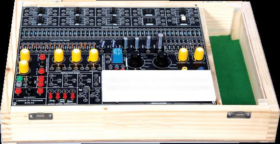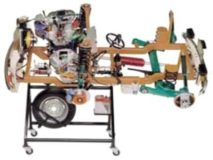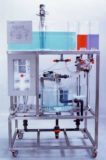Rotational Inertia Model MT 141
Home » Products » Rotational Inertia Model MT 141
Rotational Inertia Model MT 141
Sci-tech Rotational Inertia Model MT 141 can be used to study mass moments of inertia of rotating bodies (hollow cylinder or solid cylinder). The experimental unit is clamped to a table-top plate via two support rods.
A support rod supports the rotary axis with the studied body. The rotary axis is accelerated by a weight, pulley and cable with a drum. This results in a uniformly accelerated rotational motion. Using the measured time, mass and acceleration distance, we can calculate the mass moment of inertia. Systems with different masses and mass distributions can be studied in various geometries.
Using a rotating bar with masses, it is possible to study the mass moment of inertia as a function of the radius.
| Size: | 60cm x 55cm x 80cm (LxWxH) |
| Weight: | 20 kg |
Item Description
Features
- Investigation of mass moments of inertia in rotating, rigid bodies
The resistance with which a rigid body opposes a change to its rotation is indicated by the mass moment of inertia. Here, the behaviour of the body depends on its mass and the distribution of this mass relative to the axis of rotation. Mathematically, the quotient of the rotary moment and the angular acceleration is the mass moment of inertia.
Sci-tech Rotational Inertia Model MT 141 can be used to study mass moments of inertia of rotating bodies (hollow cylinder or solid cylinder). The experimental unit is clamped to a table-top plate via two support rods.
A support rod supports the rotary axis with the studied body. The rotary axis is accelerated by a weight, pulley and cable with a drum. This results in a uniformly accelerated rotational motion. Using the measured time, mass and acceleration distance, we can calculate the mass moment of inertia. Systems with different masses and mass distributions can be studied in various geometries.
Using a rotating bar with masses, it is possible to study the mass moment of inertia as a function of the radius.
Technical Specifications
Specifications
- Investigation of the inertia of various bodies in rotational motion
- Hollow cylinder, solid cylinder or rotating bar with masses as a rotating body
- Generate a uniformly accelerated rotational motion via weight, pulley and cable drum
- Rotating bar: adjustable position of the mass to realise different radii
- Measure the time and the acceleration distance
- Position and fix the parts via table clamps
Rotating bar
- length: 550mm
- masses: 2x 0,1kg, 2x 0,2kg, 2x 0,4kg
Solid cylinder
- diameter: 120mm
- mass: 0,9kg
Hollow cylinder
- outer diameter: 120mm
- inner diameter: 110mm
- mass: 0,9kg
Weight for the drive
- 1N
Experiment Possibilities
- Investigation of the inertia of rigid bodies in rotational motion
- determine mass moments of inertia of different, regularly shaped bodies
- Investigation of the mass moment of inertia as a function of the radius
Model Number
MT 141
See also different:

Sci-tech Analogue Electronics Trainer Model ETR002 is versatile trainer which is capable of performing the role of Linear IC Trainer, Basic Electronics Trainer, network circuit & theorems trainer, rectifier, filter & regulator trainer, [...]

Sci-tech Automotive Sectioned Structure For Educational System of a Diesel Engine Car demonstrates the inter-relationship between components of an actual car. The training model is built with the original automotive parts, fitted on a frame sp [...]


